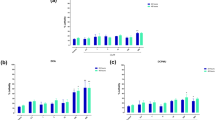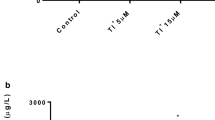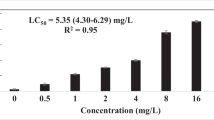Abstract
The tryptophan metabolite, quinolinic acid (QUIN), and the mitochondrial toxin 3-nitropropionic acid (3-NP) are two important tools for toxicological research commonly used in neurotoxic models of excitotoxicity, oxidative stress, energy depletion, and neuronal cell death in mammals. However, their toxic properties have yet to be explored in the nematode Caenorhabditis elegans (C. elegans) for the establishment of novel, simpler, complementary, alternative, and predictive neurotoxic model of mammalian neurotoxicity. In this work, the effects of QUIN (1–100 mM) and 3-NP (1–10 mM) were evaluated on various physiological parameters (survival, locomotion, and longevity) in a wild-type (WT) strand of C. elegans (N2). Their effects were also tested in the VC1772 strain (knock out for the antioxidant SKN-1 pathway) and the VP596 strain (worms with a reporter gene for glutathione S-transferase (GST) transcription) in order to establish the role of the SKN-1 pathway in the mode of action of QUIN and 3-NP. In N2, the higher doses of both toxins decreased survival, though only QUIN altered motor activity. Both toxins also reduced longevity in the VC1772 strain (as compared to N2 strain) and augmented GST transcription in the VP596 strain at the highest doses. The changes induced by both toxins require high doses, and therefore appear moderate when compared with other toxic agents. Nevertheless, the alterations produced by QUIN and 3-NP in C. elegans are relevant to mammalian neurotoxicity as they provide novel mechanistic approaches to the assessment of neurotoxic events comprising oxidative stress and excitotoxicity, in the nematode model.





Similar content being viewed by others
References
Alexei T, Hughes PE, Faull RL, Williams CE (1998) 3-Nitropropionic acid’s lethal triplet: cooperative pathways of neurodegeneration. Neuroreport 9:57–64
Ali SJ, Rajini PS (2012) Elicitation of dopaminergic features of Parkinson’s disease in C. elegans by monocrotophos, an organophosphorous insecticide. CNS Neurol Disord Drug Targets 11:993–1000
An JH, Blackwell TK (2003) SKN-1 links C. elegans mesendodermal specification to a conserved oxidative stress response. Genes Develop 17:1882–1893
Arantes LP, Peres TV, Chen P, Caito S, Aschner M, Soares FA (2016) Guarana (Paullinia cupana Mart.) attenuates methylmercury-induced toxicity in Caenorhabditis elegans. Toxicol Res 5:1629–1638
Avila DS, Benedetto A, Au C, Bornhorst J, Aschner M (2016) Involvement of heat shock proteins on Mn-induced toxicity in Caenorhabditis elegans. BMC Pharmacol Toxicol 17:54
Bélanger M, Allaman I, Magistretti PJ (2011) Brain energy metabolism: focus on astrocyte-neuron metabolic cooperation. Cell Metab 14:724–738
Bhattacharyya A, Chattopadhyay R, Mitra S, Crowe SE (2014) Oxidative stress: an essential factor in the pathogenesis of gastrointestinal mucosal diseases. Physiol Rev 94:329–354
Blackwell TK, Steinbaugh MJ, Hourihan JM, Ewald CY, Isik M (2015) SKN-1/Nrf, stress responses, and aging in Caenorhabditis elegans. Free Radic Biol Med 88:290–301
Borlongan CV, Koutouzis TK, Sanberg PR (1997) 3-Nitropropionic acid animal model and Huntington’s disease. Neurosci Behav Rev 21:289–293
Brockie PJ, Mellem JE, Hills T, Madsen DM, Maricq AV (2001) The C. elegans glutamate receptor subunit NMR-1 is required for slow NMDA-activated currents that regulate reversal frequency during locomotion. Neuron 31:617–630
Colín-González AL, Luna-López A, Königsberg M, Ali SF, Pedraza-Chaverrí J, Santamaría A (2014) Early modulation of the transcription factor Nrf2 in rodent striatal slices by quinolinic acid, a toxic metabolite of the kynurenine pathway. Neuroscience 260:130–139
Essa MM, Braidy N, Vijayan KR, Subash S, Guillemin GJ (2013) Excitotoxicity in the pathogenesis of autism. Neurotox Res 23:393–400
Fagundez DA, Câmara DF, Salgueiro WG, Noremberg S, Puntel RL, Piccoli JE, Garcia SC, Rocha JBT, Aschner M, Ávila DS (2015) Behavioral and dopaminergic damage induced by acute iron toxicity in Caenorhabditiss elegans. Toxicol Res 4:878–884
Federico A, Cardaioli E, Da Pozzo P, Formichi P, Gallus GN, Radi E (2012) Mitochondria, oxidative stress and neurodegeneration. J Neurol Sci 322:254–262
González-Hunt CP, Leung MC, Bodhicharla RK, McKeever MG, Arrant AE, Margillo KM, Ryde IT, Cyr DD, Kosmaczewski SG, Hammarlund M, Meyer JN (2014) Exposure to mitochondrial genotoxins and dopaminergic neurodegeneration in Caenorhabditis elegans. PLoS One 9:e114459
Guillemin GJ (2012) Quinolinic acid, the inescapable neurotoxin. FEBS J 279:1356–1365
Joshi G, Johnson JA (2012) The Nrf2-ARE pathway: a valuable therapeutic target for the treatment of neurodegenerative diseases. Recent Pat CNS Drug Discov 7:218–229
Kano T, Brockie PJ, Sassa T, Fujimoto H, Kawahara Y, Iino Y, Maricq AV (2008) Memory in Caenorhabditis elegans is mediated by NMDA-type ionotropic glutamate receptors. Curr Biol 18:1010–1015
Keating DJ (2008) Mitochondrial dysfunction, oxidative stress, regulation of exocytosis and their relevance to neurodegenerative diseases. J Neurochem 104:298–305
Kumsta C, Thamsen M, Jakob U (2011) Effects of oxidative stress on behaviour, physiology, and the redox thiol proteome of Caenorhabditis elegans. Antioxid Redox Signal 14:1023–1037
Maricq AV, Lin C, Brockie PJ, Madsen DM (2000) Genetic analysis of NMDA receptor expression in C. elegans. West Coast Worm Meeting
Martínez-Finley EJ, Caito S, Slaughter JC, Aschner M (2013) The role of SKN-1 in methylmercury-induced latent dopaminergic neurodegeneration. Neurochem Res 38:2650–2660
Mehta A, Prabhakar M, Kumar P, Deshmukh R, Sharma PL (2013) Excitotoxicity: bridge to various triggers in neurodegenerative disorders. Eur J Pharmacol 698:6–18
Murakami S, Murakami H (2005) The effects of aging and oxidative stress on learning behaviour in C. elegans. Neurobiol Aging 26:899–905
Olney JW (1990) Excitotoxicity: an overview. Can Dis Wkly Rep 1E:47–58
Pérez-De La Cruz V, Carrillo-Mora P, Santamaría A (2012) Quinolinic acid, an endogenous molecule combining excitotoxicity, oxidative stress and other toxic mechanisms. Int J Tryptophan Res 5:1–8
Pérez-Severiano F, Rodríguez-Pérez M, Pedraza-Chaverrí J, Maldonado PD, Medina-Campos ON, Ortiz-Plata A, Sánchez-García A, Villeda-Hernández J, Galván-Arzate S, Aguilera P, Santamaría A (2004) S-Allylcysteine, a garlic-derived antioxidant, ameliorates quinolinic acid-induced neurotoxicity and oxidative damage in rats. Neurochem Int 45:1175–1183
Rami A (2009) Review: autophagy in neurodegeneration: firefighter and/or incendiarist? Neuropathol Appl Neurobiol 35:449–461
Rami A, Ferger D, Krieglstein J (1997) Blockade of calpain proteolytic activity rescues neurons from glutamate excitotoxicity. Neurosci Res 27:93–97
Rodríguez M, Snoek LB, De Bono M, Kammenga JE (2013) Worms under stress: C. elegans stress response and its relevance to complex human disease and aging. Trends Genet 29:367–374
Sawin ER, Ranganathan R, Horvitz HR (2000) C. elegans locomotory rate is modulated by the environment through a dopaminergic pathway and by experience through a serotonergic pathway. Neuron 26:619–631
Shashikumar S, Pradeep H, Chinnu S, Rajini PS, Rajanikant GK (2015) Alpha-linolenic acid suppresses dopaminergic neurodegeneration induced by 6-OHDA in C. elegans. Physiol Behav 151:563–569
Silva-Adaya D, Pérez-De La Cruz V, Herrera-Mundo MN, Mendoza-Macedo K, Villeda-Hernández J, Binienda Z, Ali SF, Santamaría A (2008) Excitotoxic damage, disrupted energy metabolism, and oxidative stress in the rat brain: antioxidant and neuroprotective effects of L-carnitine. J Neurochem 105:677–689
Silva-Palacios A, Colín-González AL, López-Cervantes SP, Zazueta C, Luna-López A, Santamaría A, Königsberg M (2017) Tert-buthylhydroquinone pre-conditioning exerts dual effects in old female rats exposed to 3-nitropropionic acid. Redox Biol 12:610–624
Stefanello ST, Gubert P, Puntel B, Mizdal CR, de Campos MM, Salman SM, Dornelles L, Avila DS, Aschner M, Soares FA (2015) Protective effects of novel organic selenium compounds against oxidative stress in the nematode Caenorhabditis elegans. Toxicol Rep 2:961–967
Strange K (2006) An overview of C. elegans biology. Methods Mol Biol 351:1–11
Ting KK, Brew BJ, Guillemin GJ (2009) Effect of quinolinic zcid on human sstrocytes morphology and functions: implications in Alzheimer’s disease. J Neuroinflammation 6:36
Túnez I, Montilla P, Del Carmen-Munoz M, Feijóo M, Salcedo M (2004) Protective effect of melatonin on 3-nitropropionic acid-induced oxidative stress in synaptosomes in an animal model of Huntington’s disease. J Pineal Res 37:252–256
Túnez I, Tasset I, Pérez-De La Cruz V, Santamaría A (2010) 3-Nitropropionic acid as a tool to study the mechanisms involved in Huntington’s disease: past, present and future. Molecules 15:878–916
Wang R, Mason DE, Choe KP, Lewin AS, Peters EC, Luesch H (2013) In vitro and in vivo characterization of a tunable dual-reactivity probe of the Nrf2-ARE pathway. ACS Chem Biol 8:1764–1774
Xu JX, Deng X (2013) Biological modeling of complex chemotaxis behaviors for C. elegans under speed regulation—a dynamic neural networks approach. J Comput Neurosci 35:19–37
Acknowledgments
The authors want to express gratitude to Dr. Pan Chen and Anamaria Savarino for their excellent technical assistance.
Author information
Authors and Affiliations
Corresponding author
Ethics declarations
Conflict of Interest
The authors declare that they have no conflict of interest.
Rights and permissions
About this article
Cite this article
Kotlar, I., Colonnello, A., Aguilera-González, M.F. et al. Comparison of the Toxic Effects of Quinolinic Acid and 3-Nitropropionic Acid in C. elegans: Involvement of the SKN-1 Pathway. Neurotox Res 33, 259–267 (2018). https://doi.org/10.1007/s12640-017-9794-x
Received:
Revised:
Accepted:
Published:
Issue Date:
DOI: https://doi.org/10.1007/s12640-017-9794-x




